

| Home | For sale | Site map | Contact information | Guest book | Stielhandgranate 24 menu |
 Stielhandgranate
24 Stielhandgranate
24  |
|---|
|
Markings on the Stielhandgranate 24 German WW2 manufactured material was marked with an array of different markings. The markings on the Stielhandgranate 24 were put there to tell ordnance personnel who made it, when it was made and which Waffen Amt office that had approved the finished product. Depending on when it was made, there was also information about which manufacturer that had delivered the explosives and when, or which type of explosive it contained and when it was made. Early production grenades also had a user-instruction applied, and some grenades also had markings relating to the internal quality controls of the manufacturer. The following description is valid for a mid-1940 manufactured Stielhandgranate 24. The markings on the Sprengkapseln and Brennzünder will not be discussed here. The "identity" markings on the Stielhandgranate 24 consisted of the normal combination, found on most German WW2 ordnance and weapons related equipment.  A WaA (approved by an inspector) mark can be found on the head (white ink or metal-stamp), on the upper part of the handle (wooden stamp with black or blue ink) and on the safety cap at the end of the handle on early versions (metal stamp). The year of manufacture and makers code/mark can be found on the handle (hot-iron) and top of the can (metal stamp). Up until 1942 the full four digits were used for the year of manufacture. From 1942 only the last two digits were used (42-43-44-45), and some factories stamped only the last digit from the end of 1944 (4 or 5). The code "ЯR564" on this example is "Wilhelm von Hagen Metallwarenfabrik, Iserlohn Westfalen" For further details about the maker codes see the "Makers of the Stielhandgranate 24" page. From 1924 to 1935 a one-letter-year date-code was in use. For further details about this see the "Richard Rinker and the "ЯR" mystery" page. 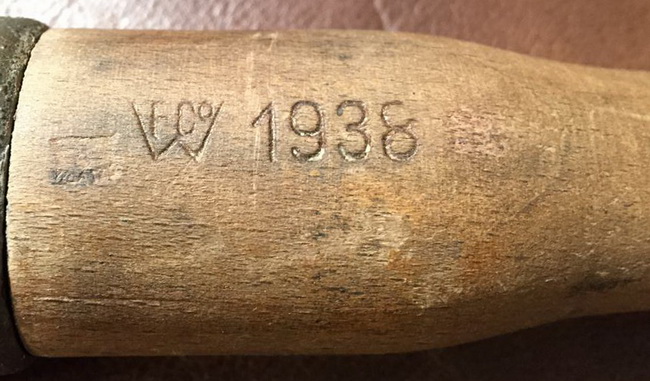 The only known example of a Stielhandgranate 24 that has actually been marked with a maker's logo or full name is the one pictured above, owned by Tighe, USA. At the same time, this is the only known example of a Stielhandgranate 24 manufactured by this company. It is the company logo of Fritz Weber & Co. Laternenfabrik Berlin. This company used the post-1940 code brc, and is mainly known for their MG barrel carriers and ammunition cans. The inked markings on the side of the can relates to the explosive filling of the paper bag that was placed inside the head. Since the explosive came from a sub-contractor, the assembly plant had to mark the heads with the ink-stamps to describe the contents. Different explosive manufacturers supplied the waxed paper bags filled with the Füllpulver 02 or Donarit to the different Stielhandgranate 24 manufacturers. The marking on the handgrenade two pictures above is "K 4 8/40". The "K" stands for Kalt (cold), denoting that the explosive was guaranteed to function as normal even in arctic climates. "4" presumably denotes the type of explosive filling, and 8/40 is the date that the explosive filling was manufactured; August 1940. Up until 1940 the ink stamp will tell who made the explosives and when. From 1940 and onwards the ink stamp will specify the type of explosives and when it was made. A late war version. "K syn Do 3/1944" should translate to "For use in Cold weather, filled with synthetic Donarit, made in March 1944".  6 different varieties. Upper row shows Donarit filled cans from 1940 to 1944. Lower row shows that the explosive fillings were manufactured by WASAG. "Rdf." is a code from the code system for explosive manufacturers, which was introduced on 07.09.1936. "Westfälische-Anhaltische Sprengstoff AG, Werk Reinsdorf" was often shortened as "WASAG", but here it is the location Reinsdorf that has been coded to "Rdf". Incidentally the code "Rdf." was only lightly changed when the new three-letter code system was introduced in 1940. The new code was "rdf". The lower row doesn't state what kind of explosive the cans have been filled with, only who made it and when. 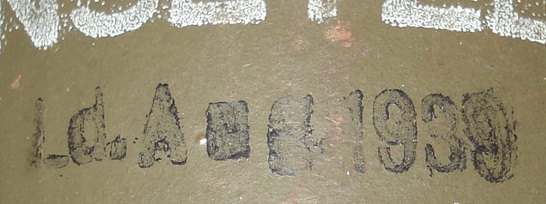 The above marking reads "Ld. Aug 1939" and denotes that the explosives were made in August 1939 in Lechfeld & Depyfag G.m.b.H, Werk Neumarkt/Oberpfalz.  The above marking reads "Sk. 4 1939" and denotes that the explosives were made in April 1939 in Lignose Sprengstoffwerk GmbH, Werk Schönebeck, Elbe. 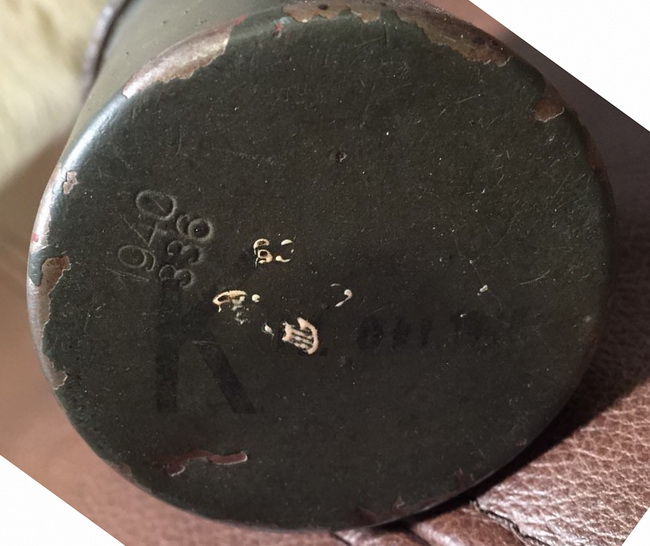 Picture courtesy of Tighe, USA A variation of the markings can be found on Stielhandgranaten 24 marked "336 1940" made by Richard Rinker G.m.b.H. in Menden/Iserlohn, WaA65. These have no marking to the side of the can, but the "K" and filling details stamped to the top of the head.
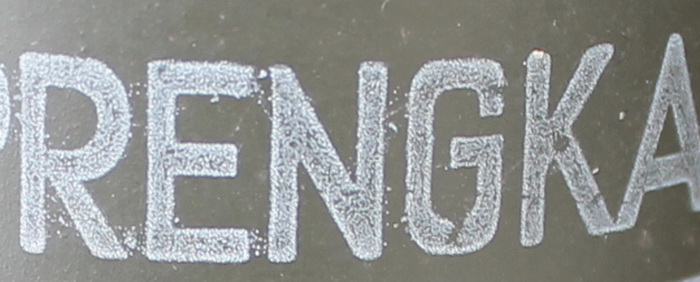 The text with the warning was always painted in white paint, and applied with a rolled stamp, leaving a pattern of micro-dots. Original Stielhandgranaten have been observed with yellowish paint, but these have become yellow due to a postwar coating of lacquer, or simply from aging. The factory color was always white. 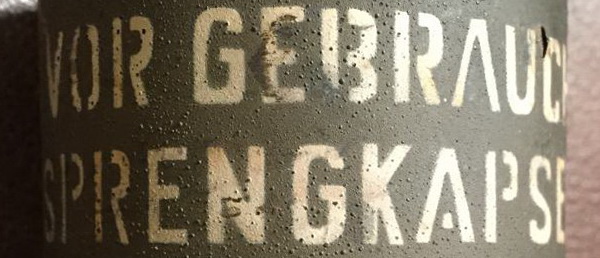 Picture courtesy of Tighe, USA One exception from the rolled stamp has been observed. The above Stielhandgranate 24 has the standard warning text applied by the use of a stencil (note how the letters have lines going through them). The maker has not been verified, but it is believed to be Fritz Weber & Co. Laternenfabrik Berlin. These letters will not have the typical micro-dots resulting from the roll stamp above.  Strictly not a Stielhandgranate 24, but a swedish Spränghandgranat M/39. Identical in every aspect except for the markings. Neutral Sweden purchased 350 000 Stielhandgranate 24 from Germany in 1941/42. Cans are marked with a yellow ring in the same spot as the waterproofing was normally applied. Since it was an export item they are stamped with the makers logo instead of an ordnance code. Due to this both head and handle is marked "ЯR 1941". Sweden also had a design of their own called the Spränghandgranat M/39B and C, but these had the head crimped over the floor plate, opposite design of the German Stielhandgranate 24; and a safety cap of the same type that was used on the Stielhandgranate 15.   Picture above show a BLIND (inert) Spränghandgranat M/39 and a picture from a manual of the Spränghandgranat m/39 C. The difference between the Swedish made "B" and "C" model was allegedly that the "C" model had a pull wire made of metal. The following markings are not that easy to explain, but will be included anyway. 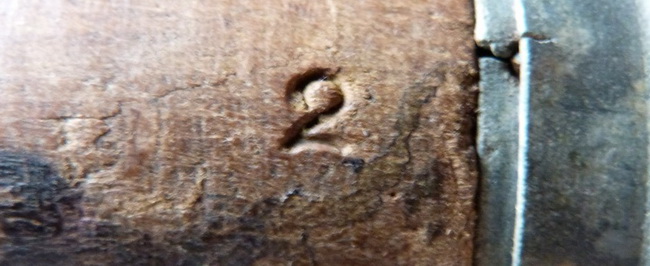 Picture courtesy of Nick Jeans Stielhandgranaten 24 manufactured by wc, Hugo Schneider AG, Metalwarenfabrik Leipzig, Werk Meuselwitz, Thuringia (HASAG) can be found with the number "2" stamped to the end of the handle. It is believed to be a control number used during production at this specific factory.  This 42 evy has a red ring painted around the handle, but the purpose is not known.  This brb 43 has a black painted ring around the upper lip of the raincap. Undoubtedly period done, but not explainable. 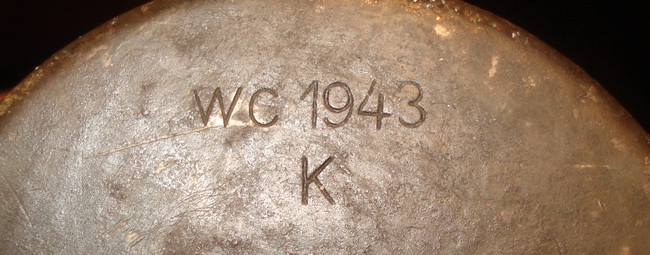 A wc 1943, manufactured by Hasag, Hugo Schneider AG, Metalwarenfabrik Leipzig, Werk Meuselwitz, Thuringia. The maker marking is followed by a large "K". The reason for this added marking is unknown. What springs to mind is that it is supposed to "mirror" the large "K" stamped in ink to the side, but that wouldn't make any sense, as the filling of explosives was delivered by another manufacturer. 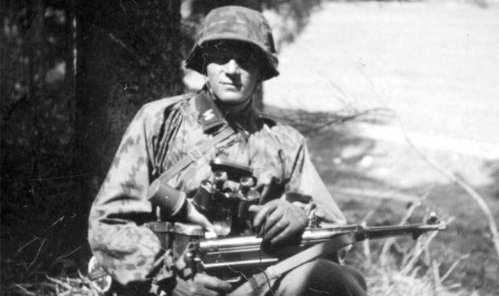 A SS Unterscharführer with a Stielhandgranate 24 in his belt. Note the very light secondary weatherproofing paint applied at the factory. Could almost be (and has been) misidentified as a yellow ring! Go back to the Stielhandgranate 24 menu |
||||||
| Home | For sale | Site map | Contact information | Guest book | Stielhandgranate 24 menu |